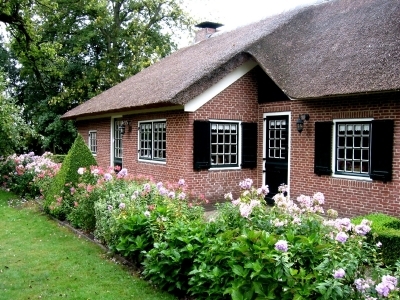A common choice a classic or traditional appearance for a roof would include materials such as shake shingles or clay, although slate is perhaps the best class look but also very expensive. Very little is heard about a thatched roof. It is not the most common design today, especially in urban areas; however, it remains a beautiful styles and is worth considering for a truly time-honored look.
shingles or clay, although slate is perhaps the best class look but also very expensive. Very little is heard about a thatched roof. It is not the most common design today, especially in urban areas; however, it remains a beautiful styles and is worth considering for a truly time-honored look.
Basics
This style is undoubtedly a true classic because it is one of the oldest and most popular roofing methods ever used. It was popular centuries ago because of the abundance of material available such as long grasses such as water reed, long straw, combed wheat reed, rushes and heather.
In order to be used, it had to be dried under the sun. There were various methods of attaching the dried grass depending upon the location; the thatching method has been used from Europe to Asia as there are many variations. One common installation method is accomplished by fixing strands across horizontal sways and hairpin spars; modern installation uses grasses fixed to top of a solid decking with an underlayment in between to provide durability.
Even though a thatched roof is somewhat loose, it is still virtually impenetrable by water even without a decking or an underlayment installed. The layered straw is usually about 12 to 15 inches thick and water can only typically soak through an inch. The steep slope of a thatched roof of usually 50 degrees improves its water resistance by allowing water to quickly travel down the slope.
Advantages and Disadvantages
The biggest advantage of a thatched roof where straw or other similar materials are abundant is the low cost of installation. On farms with an abundant supply of straw, the material is basically free.
The beauty of a thatched roof is also quite unique since it has a glow and sense of warmth. This is the reason why some modern homes located in urban areas use them even the cost is high for the shipment of the material.
The decline of this style started at the beginning of the industrial era. As farmland was driven further away because of urban expansion, the supply of straw declined as well, making it almost obsolete. The difficulty to obtain this material is still the main reason why the style remains uncommon; however, there are those who are willing to pay a premium price just to achieve the classic appearance of a thatched roof.
Insurance costs are considerably higher due to a perceived risk to fire. While this is not always true since a fire deterrent can be applied to the material, a higher insurance premium will most likely be paid.
Maintenance
As with any other roofing system, a thatched roof requires proper maintenance. Well-maintained thatching can last up to 15 years before requiring replacement. Maintenance requirements are quite unique because of the soft loose straw from which it is made. It easily attracts birds, mice and even squirrels; so an inspection should be done quite often to check for out-of-place straw that could be hosting some uninvited wildlife. Shedding is completely normal as the exposed strands will eventually decompose and fall. Once the thickness of the layer is reduced to 3/4 of its original size, a new layer of straw should be installed on top of the old one.
This style of roof has a wonderful ‘olden-times’ appeal. Anyone looking for that old country feel would surely enjoy this kind of structure; however, it must be remembered that the once-inexpensive material is now extremely expensive. Hopefully this article has provided some helpful information regarding the advantages and disadvantages of thatched roofs as what is need to main them!
Call the Schulte Roofing Experts for Your Houston Roof Needs!
Are you looking for a Houston roof company who is knowledgeable about thatched roofing? Call Schulte Roofing at 800-367-7663 for information about this unique style and many other types of roofs for all greater Houston area customers!
